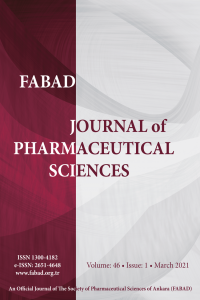Drug Administration via Feeding Tube in Intensive Care Unit: A Cross-sectional Study
Drug Administration via Feeding Tube in Intensive Care Unit: A Cross-sectional Study
___
- Ayık, D.B., & ENÇ, N. (2019). Yoğun Bakım Hastalarında Enteral Beslenme, Yoğun Bakım Hemşireliği Dergisi, 23(2), 114- 122.
- Bahar, M. (2022). Yoğun Bakımda Kritik Hastada Nütrisyon, 5.Ulusal İç Hastalıkları Kongresi, Antalya.
- ISSN: 1300-4182
- Yayın Aralığı: Yılda 3 Sayı
- Başlangıç: 2005
- Yayıncı: FABAD Ankara Eczacılık Bilimleri Derneği
Kamlesh J WADHER, Vaishnavi RAUT, Keshav HİRAVE, Sagar TRİVEDİ, Milind UMEKAR
Yeni Parasetamol-Triazol Konjugatlarının Sentezi ve Biyolojik Değerlendirmesi
Necla KULABAŞ, Merve GÜRBOĞA, Özlem BİNGÖL ÖZAKPINAR, Jianyang LİU, Per-johan JAKOBSSON, Özkan DANIŞ, Ayşe OGAN, İlkay KÜÇÜKGÜZEL
Metabolomic Studies in Girls With Central and Peripheral Precocious Puberty
Aylin BALCI ÖZYURT, Tuba REÇBER, Emirhan NEMUTLU, Derya BULUŞ, Sedef KIR, Belma KOÇER GÜMÜŞEL, Pınar ERKEKOĞLU
Zübeyde TANRIVERDİ, Burak KUZU, Ergül EYOL, Fuat KARAKUŞ
Anticancer Potential of Novel Nanoemulgel Formulations in Melanoma
Drug Administration via Feeding Tube in Intensive Care Unit: A Cross-sectional Study
Nursel SURMELİOGLU, Yaren İLERİ, H Murat GÜNDÜZ, Dilek ÖZCENGİZ
Mucoadhesive Drug Delivery Systems for Pediatric and Geriatric Patients
Arya RAİ, Shristhi Sohan RAWAT, Ritu RATHİ, Deepika RAİNA, Oluwatoyin A. ODEKU, Inderbir SİNGH
Anayatollah SALİMİ, Ramin NOORAFROOZ, Maryam FOULADİ, Saeed MOHAMMAD SOLEYMANİ
